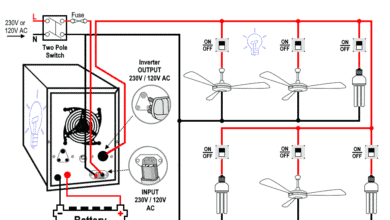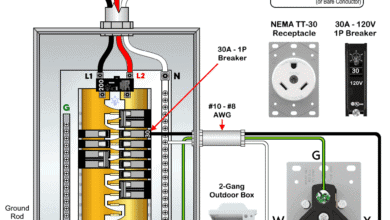Why Doesn’t a Standard Breaker Protract Against Ground Faults?
Why Does a Standard Breaker Pose a Shock Hazard with a Broken Neutral?
A broken neutral in a circuit with a standard breaker can pose a shock hazard because the breaker does not monitor or protect the neutral wire. The internal mechanism of an ordinary breaker is not designed to detect the ground fault current during the operation. A standard circuit breaker is designed to protect against overloads and short circuits but not ground faults.
Standard circuit breakers monitor the current flowing through the hot wire and will trip if this current exceeds the breaker’s rating, typically due to an overload or a short circuit. However, in the case of a broken neutral, fault current may find its way back to the source through the ground wire. This happens because the ground and neutral terminal bars are bonded in the main panel.
Consequently, a lower current than the breaker’s rated capacity can flow through the circuit, completing it in an unintended way. Since there is no excessive current flowing through the hot wire, the breaker does not detect a fault and stays closed. As a result, parts of the circuit remain live, creating a hidden shock risk that the breaker does not address.
Related Posts:
- How Does a Standard Breaker Respond to Electrical Fault?
- How Do GFCI and Standard Breakers Respond to Ground Faults?
The most common faults occur in an electric circuit are as follow:
- Overloads and Short Circuits: Standard breakers respond to excessive current flow caused by an overload or a direct short circuit (a high-current fault where current flows directly from hot to neutral or hot to hot). These conditions cause a surge of current, which the breaker detects and trips to prevent damage.
- Ground Faults: A ground fault occurs when current leaks from the hot wire to a grounded surface, bypassing the neutral wire (for example, in case of broken neutral wire or if a live wire touches a metal appliance case or a wet surface). Ground faults may not result in the high current surges needed to trip a standard breaker, especially if only a small amount of current leaks to ground. Instead, this leakage could cause severe shock hazards without reaching the trip threshold of a standard breaker.
Related Post: Why Do We Need a GFCI & How Does it Protect During Faults?
How a Standard Breaker Responds to a Short Circuit or Ground Fault?
Let’s look at the illustrations below to see how a standard breaker treats and responds to a short circuit or ground fault in a circuit.
Consider the following example: the neutral is lost in a 120V/240V main panel, where a lighting circuit is controlled and protected by a 15-amp standard breaker on a 120V supply.
As shown in the figure, if the neutral is unavailable in the main panel, the return current will attempt to flow back to the neutral bar. Since the neutral bar is bonded to the ground bar, this current finds its only available path back to the source—typically the transformer—via the ground wire. In this scenario, a circuit is formed, allowing approximately 2.4 amps of fault current to flow. The light bulb may still glow, but it will be dim.
Click image or open in new tab to enlarge
This 2.4-amp fault current is far below the 15-amp rating of the breaker, so it does not trip. As a result, the circuit poses a shock hazard, with all metal parts—including equipment enclosures, metal raceways, and metallic bodies of connected devices—becoming electrified with approximately 72V AC.
Related Posts:
- Why are Neutral and Ground Wires Separated in a Subpanel?
- Why Must Neutral and Ground Wires Be Bonded in the Main Panel?
- What Happens if the Neutral is Lost in the Main or Subpanel?
Now, let’s consider another scenario where the neutral is lost and the hot wire comes into contact with the metallic body of the device, creating a “double fault.” In this case, the light is off because there is no load resistance. A fault current of approximately 4 amps flows through the ground conductor to the source, as shown in the figure.
Click image or open in new tab to enlarge
Again, all metal parts in the circuit become energized, now with 120V AC. This 4-amp fault current is still below the 15-amp threshold of the breaker, so it remains untripped. If an operator touches the equipment enclosure, metal raceway, or metallic body of the device, they may receive a severe electric shock.
To prevent these serious hazards, a GFCI (Ground Fault Circuit Interrupter) breaker is recommended instead of a standard breaker. GFCI breakers are designed to detect ground faults and provide safer operation by tripping in these hazardous situations, including those caused by a broken neutral.
Resources & Tutorials:
- National Electrical Code (NEC) Requirements for Panelboards
- How to Find the Right Wire Size for 100A Service 120V/240V Panel?
- How to Determine the Right Size Capacity of a Subpanel?
- How to Wire a Subpanel? Main Lug Installation for 120V/240V
- How to Determine the Number of Circuit Breakers in a Panel Board?
- How to Size a Load Center, Panelboards and Distribution Board?
- How to Wire 120V & 240V Main Panel? Breaker Box Installation
- How to Wire a GFCI Circuit Breaker?
- How to Wire and Install an Electrical Outlet Receptacle?
- How to Wire a GFCI Outlet?
- How to Wire GFCI Combo Switch and Outlet
- What Happens When You Touch an Electrical Busbar?
- Can the Neutral Wire Cause Electric Shock? Different Cases
- Difference Between Grounding, Earthing and Bonding
- Difference Between Neutral, Ground and Earth?
- Will I Get an Electric Shock If I Touch the Ground Wire?
- Will a Man Get an Electric Shock If He Hangs on a Live Wire?
- Difference Between Circuit Breaker and GFCI
- Tripping Curves of Circuit Breakers – B, C, D, K and Z Trip Curve








